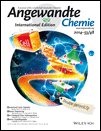Reversibly Controlling Preferential Protein Adsorption on Bone Implants by Using an Applied Weak Potential as a Switch†
This work was supported by the National Basic Research Program of China (Grant No. 2012CB619100) and the National Natural Science Foundation of China (Grant Nos. 51372087, 51072057). Y.Z. and C.M. would like to thank the financial support from National Institutes of Health (EB015190), National Science Foundation (CBET-0854414, CMMI-1234957, and DMR-0847758), Department of Defense Peer Reviewed Medical Research Program (W81XWH-12-1-0384), Oklahoma Center for Adult Stem Cell Research (434003), and Oklahoma Center for the Advancement of Science and Technology (HR14-160). We would like to thank Xuliang Deng’s group at Peking University for their assistance during the experiments.
Graphical Abstract
Face changer: Taurocholic acid (TCA), a biomolecule found in bile, is doped into 1D nanoarchitectured conducting polymers designed to aid cell growth on bone implants. The orientation of the hydrophobic α-face and hydrophilic β-face of TCA in the polymeric matrix can be changed by applying an electrical potential. This switching also causes a reversible change in wettability and protein adsorption as well as in adhesion and spreading of osteoblasts on the polymer surface.
Abstract
A facile method is needed to control the protein adsorption onto biomaterials, such as, bone implants. Herein we doped taurocholic acid (TCA), an amphiphilic biomolecule, into an array of 1D nano-architectured polypyrrole (NAPPy) on the implants. Doping TCA enabled the implant surface to show reversible wettability between 152° (superhydrophobic, switch-on state) and 55° (hydrophilic, switch-off state) in response to periodically switching two weak electrical potentials (+0.50 and −0.80 V as a switch-on and switch-off potential, respectively). The potential-switchable reversible wettability, arising from the potential-tunable orientation of the hydrophobic and hydrophilic face of TCA, led to potential-switchable preferential adsorption of proteins as well as cell adhesion and spreading. This potential-switchable strategy may open up a new avenue to control the biological activities on the implant surface.





